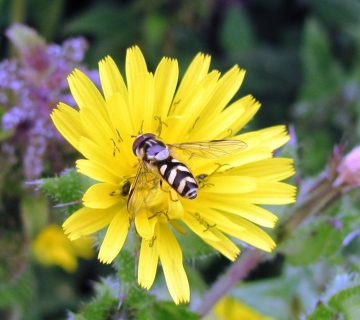Peter - in the same magazine Peter Wright, who writes a section on beetles, raises the point that the advent of the digital camera has led to a plethora of websites devoted to insect ID, not all of which are reliable. Many show pictures which are incorrectly identified or on which key features for specific determination are not visible. This may have been the case with your attempts to identify the hoverfly. One he recommends for beetles - and which I used to tentatively identify my recent photo of a Tan Bark Longhorn - is run by the Watford Coleoptera Group (http://thewcg.org.uk/) and another, for longhorns (www.cerambyx.uochb.cz/) he rates as excellent. The upside of digital photography is that it has helped generate a burgeoning interest in previously 'unfashionable' groups of insect but as Peter Wright states the various websites devoted to them need to stress the limitations of correct insect ID from photographs. That way they can both encourage and direct the interest of potential new recruits.
The important thing, in my view, is no one should every be afraid of making honest mistakes. You learn as you go along. Among my many sins is that I am a birdwatcher (or rather a 'Birder', which is the masculine version of the same thing and the one they insist on using nowadays). Birdwatching encompasses many levels of interest whereas 'Birders' are more typically concerned with rare or unusual species. At its extreme it can be extraordinarily competitive and sometimes quite nasty. Many see their lists in terms of personal achievement - the bigger the list the bigger the achievement - and some seem to derive more pleasure from rubbishing other peoples' records than correctly identifying their own! Among the other natural history disciplines I am interested in are botany and mycology. With these, even collected specimens can be misidentified or, more often, frequently re-interpreted in the light of modern day knowledge. The County Recorder for fungi sent a specimen of a scarce Waxcap to Kew, where it was confirmed by one of the experts there. More recently, in the light of DNA analysis, it has been re-identified as a colour form of a much commoner species. That is no reflection on the skills of the expert concerned. This is happening all the time with fungi at Kew; species that were originally identified using the macro and micro characteristics thought correct at the time have subsequently been proved to be something else. When you are interested in fungi you almost expect this to happen nowadays but it does not stop you trying to identify them, using the best knowledge available to you at the time.
As for hoverflies, the book PH mentions is excellent but expensive; you could try contacting the British Hoverfly Society and see if they recommend any websites for hoverfly ID. Some are relatively easy to ID from photos but others, such as the Cheilosia, are a no no. Even in the former instance I would not seek to add them to the county database without running them past the County Recorder for hoverflies first. As for bees, I would not dare!!!
That being said I will put my ID skills where my mouth is and offer you a photo of Dasysyrphus albostriatus (I hope), taken last summer at Stow Maries Aerodrome.
























